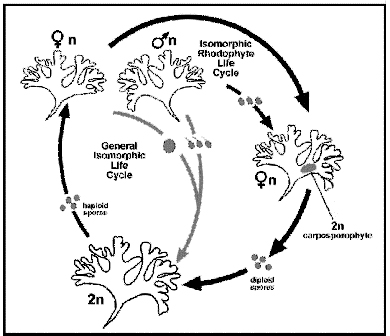My theoretical work on algal life histories addresses the role of reproductive ecology in shaping their evolution. I am interested in how selection on heterochronic variation in the timing of meiosis and elaboration of a multicellular soma fueled life cycle variation to generate either one- or two-free-living alternate generations. Ecologists have long sought adaptive explanations for the dominance by one phase in species with an alternation of generations for both heteromorphic and isomorphic life cycles. In the case of isomorphy, differences in mortality rates between generations are frequently lacking or inconsistent with expectations based on distribution patterns. Dr. Kübler, my students and I have developed a model that characterizes how fertilization rate alone, and in concert with environmental factors, can determine the ratio of gametophytes to sporophytes in a population (Fierst et al. 2005).
We are extending this model to examine the influence of fertilization success on genetic diversity of populations of haplo-diploid life cycles by affecting sporophyte abundance and explore the hypothesis that fertilization success has been a major selective force shaping life history evolution in macroalgae.







